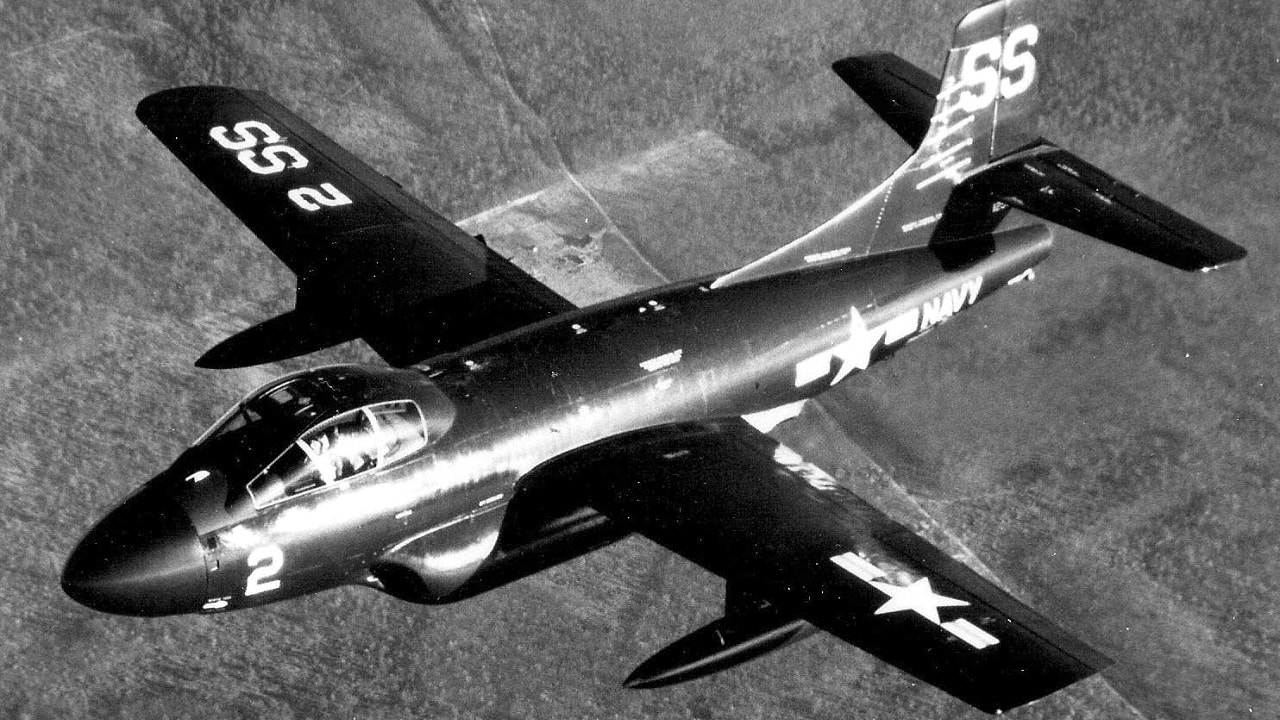The German-made Messerschmitt Me 262 “Schwalbe (Swallow)” of WWII, by virtue of being the first operational jet fighter in history, scored the first air-to-air kills by a jet fighter in history. But these were all done against piston-engine (propeller-driven) aircraft, as the Allies’ Bell P-59 Airacomet and Gloster Meteor jets never got to face off against the Me 262 before the war ended. Likewise, the first Allied pilots to kill the Me 262 jet were flying prop-driven fighters; among these overachieving Allied pilots was the legendary Chuck Yeager.
For history’s first jet-to-jet shootdown, one must fast-forward to the Korean War. The United States has the bragging rights in this arena, though there remains some controversy whether the feat was pulled off by the U.S. Air Force’s F-80 Shooting Star or the U.S. Navy’s Grumman F9F Panther. Now, as for the first nighttime jet vs. jet aerial kill, Uncle Same once again has the bragging rights, and there’s no dispute about the warbird to pull off that particular combat feat: say hello to the Douglas F3D Skyknight. (And before anybody asks, the branch of service with particular claim to fame is the U.S. Marine Corps, Semper Fi!)
F3D Skyknight Early History and Specifications
The F3D Skyknight made her maiden flight on 23 March 1948 and was officially introduced into operational service in late 1950. She was manufactured by Douglas Aircraft — whose more famous warbirds included the game-changing SBD Dauntless dive bomber of WWII and the A-1/AD-1 Skyraider of Korea and Vietnam – which later became McDonnell Douglas and eventually merged with Boeing.
Boeing’s Historical Snapshot info page on the F3D informs us that “The Douglas F3D Skyknight (later designated the F-10) was the world’s first jet fighter designed for use as a carrier-based night fighter. Its radar equipment required a wider-than-usual fuselage, so it was nicknamed ‘Willie the Whale’…The U.S. Navy asked Douglas to develop a carrier-based night fighter in 1946.” The plane the Navy received was a straight-wing, twin-engine, two-seat plane, with, in lieu of ejection seats, an escape system that allowed the crew to depart downward through the bottom of the fuselage.
Specifications included a wingspan of 50 feet, a fuselage length of 45 feet 5 inches, a height of 16 feet 1 inches, an empty weight of 14,989 pounds, and maximum landing weight 24,485 pounds. Max airspeed was 478 miles per hour, with a range of 1.068 miles. Armament consisted of four Hispano-Suiza M2 20mm cannons and two 11.75-inch Tiny Tim rockets; later editions could also carry AIM-7 Sparrow air-to-air missiles.
Subsequent to their service in the skies over Korea, Skyknights served as electronic reconnaissance and countermeasure aircraft during the Cuban Missile Crisis and the Vietnam War. The warbird attained an additional historical distinction as the only USN/USMC fighter to fly combat missions in both Korea and Vietnam. The last Skyknight was retired in 1978.
The Battle in Brief
I was unable to uncover a detailed, blow-by-blow account of it. Still, the official info page of the Combat Air Museum at Topeka Regional Airport (Forbes Field) near Topeka, Kansas, provides us with the following information:
“F3D-2 versions entered the Korean War during the spring of 1952 with Marine Corps night fighter squadrons. They escorted US Air Force B-29 Superfortresses on nighttime bombing raids over North Korea. On 2 November 1952, a Skyknight of Marine Night Fighter Squadron VMF(N)-513 scored the first shoot down in a jet versus jet night action, downing a Yak-15 jet fighter.” The successful Skyknight crew in question was USMC Major Willian Stratton and radio operator Master Sergeant Hans C. Hoagland.
Though the Yakovlev Yak-15 “Feather” didn’t attain the notoriety that the MiG-15 Fagot: did, it nonetheless made history in its own right as the Soviet Union’s first jet fighter, debuting in April 1946. It boasted a top speed of 489 mph and was armed with two 23mm Nudel-Suranov NS-23 cannons.
The Museum’s info page goes on to state that “Skyknights scored the most shoot downs of enemy aircraft by any US Navy or Marine Corps fighter-type during the Korean War. Two F3Ds were lost in Korea.” The cause of those two losses remains unknown, whilst the Skyknight’s total kill tally for the Korean War was eight, resulting in a final kill-to-loss ratio of 8:0 at best or – assuming for argument’s sake that those two F3D’s were lost to enemy air action – 4:1 at worst.
Where Are They Now?
Only one Yak-15 survives today out of the 280 originally built, that being “Yellow 47” on static display at the Vadim Zadorozhny Technical Museum outside Moscow.
As for the Skyknight, there are nine survivors out of the 268 originally produced including the one at the aforementioned Combat Air Museum. Locations that I’ve personally toured and can therefore vouch for are the National Museum of the Marine Corps in Quantico, Virginia, and the National Naval Aviation Museum at NAS Pensacola, Florida.
Christian D. Orr is a former U.S. Air Force Security Forces officer, Federal law enforcement officer, and private military contractor (with assignments worked in Iraq, the United Arab Emirates, Kosovo, Japan, Germany, and the Pentagon). Chris holds a B.A. in International Relations from the University of Southern California (USC) and an M.A. in Intelligence Studies (concentration in Terrorism Studies) from American Military University (AMU). He has also been published in The Daily Torch and The Journal of Intelligence and Cyber Security. Last but not least, he is a Companion of the Order of the Naval Order of the United States (NOUS).

